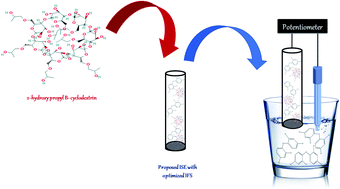In situ monitoring of triclosan in environmental water with subnanomolar detection limits using eco-friendly electrochemical sensors modified with cyclodextrins
Abstract
The environmental emergence of unexpected contaminants has gained the attention of the scientific community. A broad spectrum antimicrobial compound named triclosan (TCS) was detected in the environment as an emerging contaminant. Owing to its inherent toxicity, we have proposed eco-friendly potentiometric liquid state sensors to be used for monitoring and quantifying TCS in environmental water samples. The proposed sensors have been optimized by modifying the inner filling solution using hydrophilic 2-hydroxypropyl β-cyclodextrin as a complexing agent to be capable of minimizing the trans-membrane ion flux and hence improving the selective and sensitive determination of TCS in environmental matrices with low LOD values. The obtained linear response of the optimized sensor was (1 × 10−9 to 1 × 10−5 M) compared to the control sensor (1 × 10−8 to 1 × 10−4 M). The obtained limit of detection (LOD) value was found to be 9.86 × 10−10 M compared to 9.78 × 10−9 M of the control sensor. The modification of the inner filling solution of the sensor with 2-hydroxypropyl β-cyclodextrin improves not only its sensitivity but also its response time to be only 5 seconds. The electrical performance of the proposed sensor was evaluated following IUPAC recommendations. Both the pH and temperature effects were studied and optimized. Two different greenness assessment tools, Analytical Eco-scale and Green Procedure Index, were adopted upon the evaluation of the proposed sensors' greenness.



 Please wait while we load your content...
Please wait while we load your content...